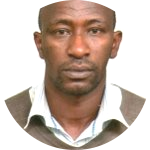In this photo taken on 20 October 2015, volunteers replant mangroves outside the Saloum Delta, Diamniadio Island in Senegal. Like millions of others across the continent, these women live on the frontline of climate change.
As Caribbean countries come to terms with the devastating effects of the recent hurricanes (Irma and Maria) that ravaged the region in September, experts are warning that the chronic underdevelopment of hydrometeorological technology and services in Africa is leaving the continent dangerously unprepared when it comes to climate-related disasters.
Hydrometeorology, the science and mechanism of observing weather behaviour in relation to water, is an important field of weather prediction as too much rain can cause as much harm as it absence.
As many as 54 per cent of the continent’s surface weather stations and 71 per cent of its “upper-air weather stations” (balloons released into atmosphere to capture weather data) are out-of-date and unable to capture accurate weather data, experts say.
As a result of this dilapidated infrastructure, countries are losing billions of dollars to weather and climate-related disasters, according to the World Bank, with millions of people across the continent affected annually.
“The increased frequency and intensity of natural disasters across sub-Saharan Africa should serve as a wake-up call for governments and the international community to invest in hydromet services,” said Makhtar Diop, World Bank Vice President for Africa.
“Improving the accuracy of weather forecasts would not only save lives but also help African cities and communities build resilience against climate change,” he said in a press release issued to mark the launch of the African Ministerial Conference on Meteorology (AMCOMET) Africa Hydromet Forum, which was held in Addis Ababa, Ethiopia in September.
Furthermore, many of the weather-related disasters that have taken place on the continent over the last two decades could have been prevented with appropriate prediction and forecasting infrastructure, according to information shared at the Forum.
“The capability to issue early warnings based on accurate forecasts is especially essential to preserve the lives and households of millions of people across Africa,” said Josefa Leonel Sacko, African Union Commissioner or Rural Economy and Agriculture.
Extreme weather and climate change is to blame for nine out of 10 disasters in Africa, threatening the continent’s economic gains with floods, droughts, tropical cyclones and landslides which cause heavy damage to infrastructure and property as well as losses to human life and livelihoods. The World Bank estimates that US$1.5 billion is needed to modernise the continent’s weather observation systems.
“Effective hydro-meteorological services, such as advanced weather and climate forecasting or simple and sustainable river level gauges, would help ensure that communities have the early warnings needed to prepare before disasters struck,” said Petteri Taalas, secretary-general of the World Meteorological Organization (WMO).
Lack of policy, lack of resources
The main challenge, however, has been a lack of resources due to competing development needs, according to Justus Kabyemera, coordinator of the Climate Development (ClimDev) Africa Special Fund at the African Development Bank (ADB).
“The main bottleneck is the lack of policy frameworks for hydromet services across the continent, which manifests itself into the lack of national budgetary allocations for the services,” he tells Equal Times.
Although many African countries are implementing related and equally important global and regional development frameworks – such as the African Union’s Agenda 2063, the ADB’s Second Climate Change Action Plan, the 2030 Agenda for Sustainable Development and the Paris Agreement, urgent attention needs to be paid to weather, water and climate services that will help communities across the continent build climate resilience.
However, Kabyemera said that while Africa’s hydromet services are substandard, it is not all doom and gloom. Some countries including South Africa, Egypt, Nigeria, Kenya and Morocco have made investments to modernise their infrastructure, said the bank official. He also noted that other countries have embarked on initiatives to strengthen their weather systems, including Benin, Chad, the Democratic Republic of Congo, South Sudan.
While funding has been a major challenge, the poor coordination of investment in the sector is also to blame for the current situation.
“Meteorological services are often part of the transport ministry and so have to compete for scarce resources with transport infrastructure projects. Investment is uncoordinated, and implementation is fractured, and often there is limited understanding on how a meteorological service actually functions,” says Mary Power, director of development and regional activities at the WMO.
On occasion, she notes, conflict and natural hazards reverse gains already made, making it difficult to provide a timeline as to when African countries will have a reliable weather infrastructure and services.
New initiatives
However, a number of initiatives led by multilateral development and governmental agencies are being implemented to improve the situation.
The WMO, in collaboration with the World Bank, the ADB, the United Nations Development Programme (UDP) and a host of aid agencies, has committed some US$100 million to support a total of 25 African countries improve weather and climate services, including services for climate-sensitive economic sectors, says Power.
The world weather body is also providing technical support for the training and education of personnel, as well as reinforcing data and information sharing across Africa. It is also working to identify additional resources to finance both meteorological infrastructure and service delivery.
“The WMO Severe Weather Forecasting Demonstration Project shares sophisticated forecasting products from global producing centres in the US and Europe with regional centres in Africa, which in turn downsize them into national-scale warnings of high-impact events like rain and storms,” Power tells Equal Times.
The ADB has been also administering institutional support to the African Climate Institutions initiative, a US$25 million project meant to enhance the capacity of African climate centres to generate and disseminate climate-related information to governments, aid agencies and the private sector.
The centres include the African Centre for Meteorological Applications for Development, an Africa-wide climate information hub based in Niamey, Niger; the Agrometeorology and Hydrology Regional Centre for Sahel and West Africa, also in Niamey; the Climate Prediction and Application Centre, focused on the Horn of Africa region and based in Nairobi, Kenya; and the Drought Monitoring Centre for southern Africa, based in Djibouti.
The ADB is also investing a further €21 million in the centres up to 2019 to provide equipment for severe weather observation, says Kabyemera.
TAHMO
One of the most potentially exciting hydromet projects in Africa is the Trans-African Hydrometeorological Observatory (TAHMO) project which aims to build a network of 20,000 low-cost, high-tech weather stations across Africa – one every 30 kilometres.
“The state of observation in Africa, with very few exceptions, is unacceptable, and has gotten much worse in recent years,” Frank Ohene Annor, who runs field operations for TAHMO, tells Equal Times. “We also know that it won’t get better by doing the same things we have tried for the last decade.”
The new generation of TAHMO weather stations, Annor says, are easy to install, easy to operate and require far less maintenance than traditional stations, which is one of the main operational costs.
“The station is compact, fits into a shoe-size box, so it doesn’t attract undue attention, and is designed specifically to be robust for the African environment.”
TAHMO already has 296 stations operational in east and west Africa. Uniquely, the stations are based in schools to help “foster a new generation of scientists” while bringing the curriculum to life.
“The stations precisely measure all standard weather parameters of rainfall, wind speed, wind direction, solar radiation, relative humidity, barometric pressure and provide additional measurements based on new sensing technology for lightning to protect school children, GPS, acceleration and electrical conductivity of rainwater,” Annor adds.
Already operating in East and West African countries, TAHMO says that the key to solving Africa’s weather monitoring issue is to seek holistic solutions, rather than just concentrate on infrastructure.
“We must think of whole new models, it is not just a hardware issue. [The problem] must be addressed within social, economic and political frameworks, and so our approach has novelty in technology, but moreover, as an enterprise,” he concludes.










